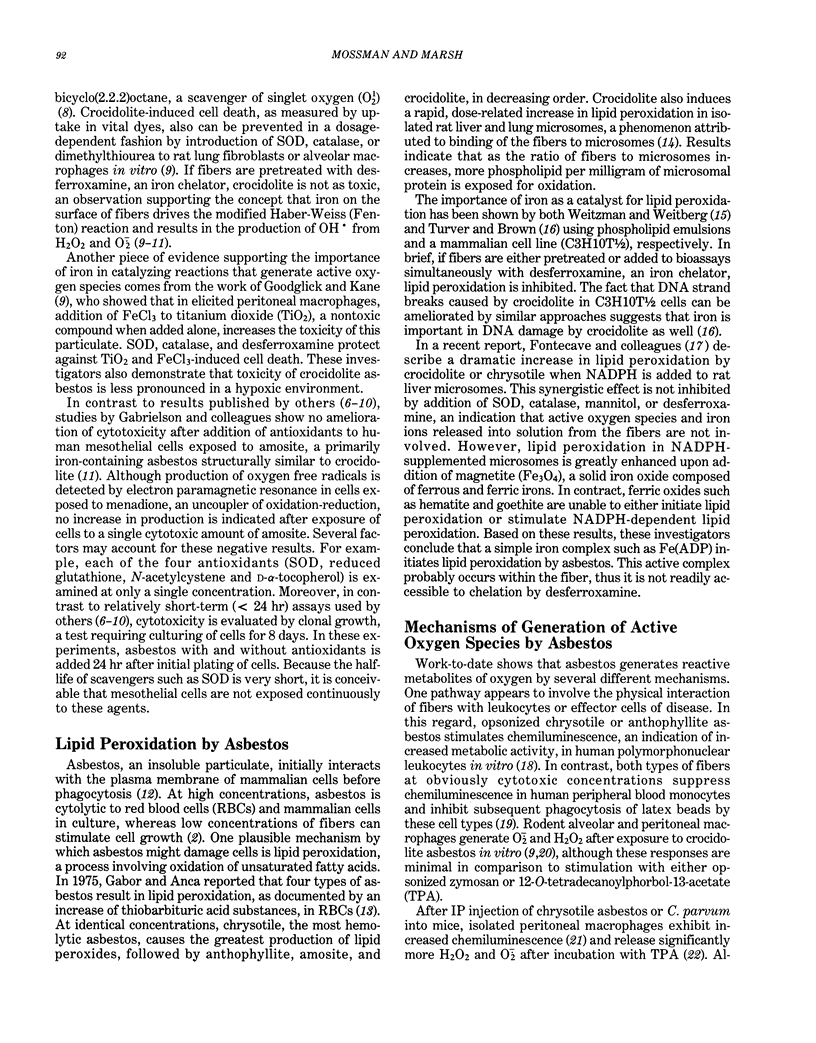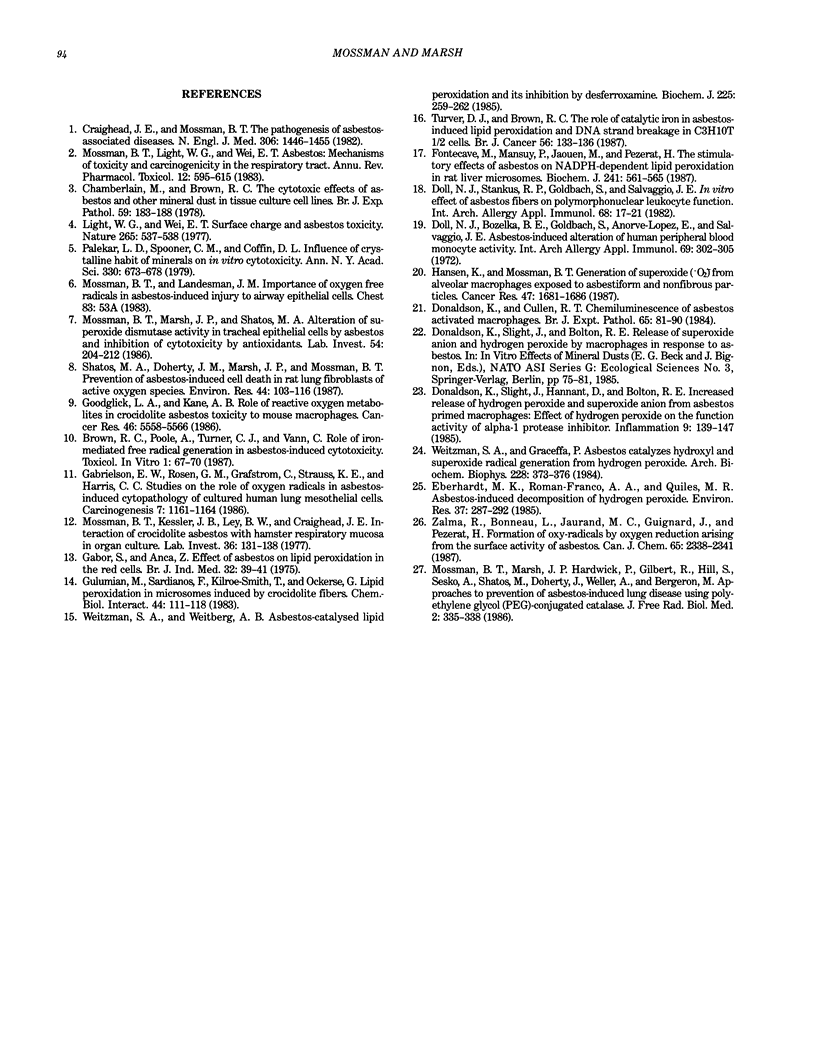Abstract
Asbestos is an important occupational and environmental toxicant that affects several cell types in the respiratory tract. In an effort to understand how asbestos causes cell injury and/or altered proliferation and differentiation of cells, this laboratory has focused on reactive oxygen species as mediators of asbestos-induced biological effects. A compendium of experimental results reported by this laboratory and others supports this hypothesis. For example, scavengers of reactive oxygen metabolites and iron chelators (i.e., desferroxamine) prevent cytotoxicity after addition of asbestos to a variety of cell lines and macrophages in vitro. DNA strand breakage associated with toxicity of crocidolite asbestos in C3H10T 1/2 cells also is ameliorated with use of desferroxamine. All types of asbestos cause lipid peroxidation in mammalian cells and artificial membranes, a phenomenon that can be prevented by removal of catalytic iron. Last, asbestos causes generation of active oxygen species after interaction with leukocytes or by reduction of oxygen on the surface of the fibers.
Full text
PDF



Images in this article
Selected References
These references are in PubMed. This may not be the complete list of references from this article.
- Chamberlain M., Brown R. C. The cytotoxic effects of asbestos and other mineral dust in tissue culture cell lines. Br J Exp Pathol. 1978 Apr;59(2):183–189. [PMC free article] [PubMed] [Google Scholar]
- Craighead J. E., Mossman B. T. The pathogenesis of asbestos-associated diseases. N Engl J Med. 1982 Jun 17;306(24):1446–1455. doi: 10.1056/NEJM198206173062403. [DOI] [PubMed] [Google Scholar]
- Doll N. J., Bozelka B. E., Goldbach S., Añorve-López E., Salvaggio J. E. Asbestos-induced alteration of human peripheral blood monocyte activity. Int Arch Allergy Appl Immunol. 1982;69(4):302–305. doi: 10.1159/000233190. [DOI] [PubMed] [Google Scholar]
- Doll N. J., Stankus R. P., Goldbach S., Salvaggio J. E. In vitro effect of asbestos fibers on polymorphonuclear leukocyte function. Int Arch Allergy Appl Immunol. 1982;68(1):17–21. doi: 10.1159/000233061. [DOI] [PubMed] [Google Scholar]
- Donaldson K., Cullen R. T. Chemiluminescence of asbestos-activated macrophages. Br J Exp Pathol. 1984 Feb;65(1):81–90. [PMC free article] [PubMed] [Google Scholar]
- Donaldson K., Slight J., Hannant D., Bolton R. E. Increased release of hydrogen peroxide and superoxide anion from asbestos-primed macrophages. Effect of hydrogen peroxide on the functional activity of alpha 1-protease inhibitor. Inflammation. 1985 Jun;9(2):139–147. doi: 10.1007/BF00917586. [DOI] [PubMed] [Google Scholar]
- Eberhardt M. K., Román-Franco A. A., Quiles M. R. Asbestos-induced decomposition of hydrogen peroxide. Environ Res. 1985 Aug;37(2):287–292. doi: 10.1016/0013-9351(85)90108-2. [DOI] [PubMed] [Google Scholar]
- Fontecave M., Mansuy D., Jaouen M., Pezerat H. The stimulatory effects of asbestos on NADPH-dependent lipid peroxidation in rat liver microsomes. Biochem J. 1987 Jan 15;241(2):561–565. doi: 10.1042/bj2410561. [DOI] [PMC free article] [PubMed] [Google Scholar]
- Gabor S., Anca Z. Effect of asbestos on lipid peroxidation in the red cells. Br J Ind Med. 1975 Feb;32(1):39–41. doi: 10.1136/oem.32.1.39. [DOI] [PMC free article] [PubMed] [Google Scholar]
- Gabrielson E. W., Rosen G. M., Grafstrom R. C., Strauss K. E., Harris C. C. Studies on the role of oxygen radicals in asbestos-induced cytopathology of cultured human lung mesothelial cells. Carcinogenesis. 1986 Jul;7(7):1161–1164. doi: 10.1093/carcin/7.7.1161. [DOI] [PubMed] [Google Scholar]
- Goodglick L. A., Kane A. B. Role of reactive oxygen metabolites in crocidolite asbestos toxicity to mouse macrophages. Cancer Res. 1986 Nov;46(11):5558–5566. [PubMed] [Google Scholar]
- Gulumian M., Sardianos F., Kilroe-Smith T., Ockerse G. Lipid peroxidation in microsomes induced by crocidolite fibres. Chem Biol Interact. 1983 Apr-May;44(1-2):111–118. doi: 10.1016/0009-2797(83)90133-3. [DOI] [PubMed] [Google Scholar]
- Hansen K., Mossman B. T. Generation of superoxide (O2-.) from alveolar macrophages exposed to asbestiform and nonfibrous particles. Cancer Res. 1987 Mar 15;47(6):1681–1686. [PubMed] [Google Scholar]
- Light W. G., Wei E. T. Surface charge and asbestos toxicity. Nature. 1977 Feb 10;265(5594):537–539. doi: 10.1038/265537a0. [DOI] [PubMed] [Google Scholar]
- Mossman B. T., Kessler J. B., Ley B. W., Craighead J. E. Interaction of crocidolite asbestos with hamster respiratory mucosa in organ culture. Lab Invest. 1977 Feb;36(2):131–139. [PubMed] [Google Scholar]
- Mossman B. T., Marsh J. P., Hardwick D., Gilbert R., Hill S., Sesko A., Shatos M., Doherty J., Weller A., Bergeron M. Approaches to prevention of asbestos-induced lung disease using polyethylene glycol (PEG)-conjugated catalase. J Free Radic Biol Med. 1986;2(5-6):335–338. doi: 10.1016/s0748-5514(86)80033-2. [DOI] [PubMed] [Google Scholar]
- Mossman B. T., Marsh J. P., Shatos M. A. Alteration of superoxide dismutase activity in tracheal epithelial cells by asbestos and inhibition of cytotoxicity by antioxidants. Lab Invest. 1986 Feb;54(2):204–212. [PubMed] [Google Scholar]
- Mossman B., Light W., Wei E. Asbestos: mechanisms of toxicity and carcinogenicity in the respiratory tract. Annu Rev Pharmacol Toxicol. 1983;23:595–615. doi: 10.1146/annurev.pa.23.040183.003115. [DOI] [PubMed] [Google Scholar]
- Palekar L. D., Spooner C. M., Coffin D. L. Influence of crystallization habit of minerals on in vitro cytotoxicity. Ann N Y Acad Sci. 1979;330:673–686. doi: 10.1111/j.1749-6632.1979.tb18771.x. [DOI] [PubMed] [Google Scholar]
- Shatos M. A., Doherty J. M., Marsh J. P., Mossman B. T. Prevention of asbestos-induced cell death in rat lung fibroblasts and alveolar macrophages by scavengers of active oxygen species. Environ Res. 1987 Oct;44(1):103–116. doi: 10.1016/s0013-9351(87)80090-7. [DOI] [PubMed] [Google Scholar]
- Turver C. J., Brown R. C. The role of catalytic iron in asbestos induced lipid peroxidation and DNA-strand breakage in C3H10T1/2 cells. Br J Cancer. 1987 Aug;56(2):133–136. doi: 10.1038/bjc.1987.170. [DOI] [PMC free article] [PubMed] [Google Scholar]
- Weitzman S. A., Graceffa P. Asbestos catalyzes hydroxyl and superoxide radical generation from hydrogen peroxide. Arch Biochem Biophys. 1984 Jan;228(1):373–376. doi: 10.1016/0003-9861(84)90078-x. [DOI] [PubMed] [Google Scholar]
- Weitzman S. A., Weitberg A. B. Asbestos-catalysed lipid peroxidation and its inhibition by desferroxamine. Biochem J. 1985 Jan 1;225(1):259–262. doi: 10.1042/bj2250259. [DOI] [PMC free article] [PubMed] [Google Scholar]



